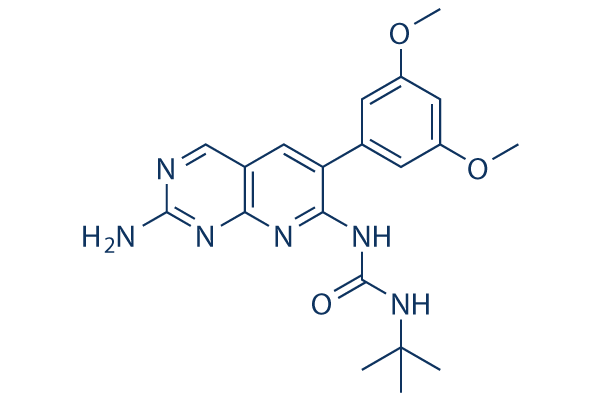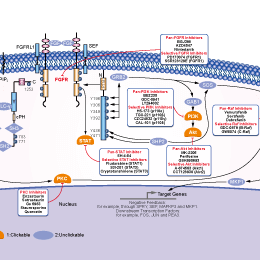
- Bioactive Compounds
- By Signaling Pathways
- PI3K/Akt/mTOR
- Epigenetics
- Methylation
- Immunology & Inflammation
- Protein Tyrosine Kinase
- Angiogenesis
- Apoptosis
- Autophagy
- ER stress & UPR
- JAK/STAT
- MAPK
- Cytoskeletal Signaling
- Cell Cycle
- TGF-beta/Smad
- DNA Damage/DNA Repair
- Compound Libraries
- Popular Compound Libraries
- Customize Library
- Clinical and FDA-approved Related
- Bioactive Compound Libraries
- Inhibitor Related
- Natural Product Related
- Metabolism Related
- Cell Death Related
- By Signaling Pathway
- By Disease
- Anti-infection and Antiviral Related
- Neuronal and Immunology Related
- Fragment and Covalent Related
- FDA-approved Drug Library
- FDA-approved & Passed Phase I Drug Library
- Preclinical/Clinical Compound Library
- Bioactive Compound Library-I
- Bioactive Compound Library-Ⅱ
- Kinase Inhibitor Library
- Express-Pick Library
- Natural Product Library
- Human Endogenous Metabolite Compound Library
- Alkaloid Compound LibraryNew
- Angiogenesis Related compound Library
- Anti-Aging Compound Library
- Anti-alzheimer Disease Compound Library
- Antibiotics compound Library
- Anti-cancer Compound Library
- Anti-cancer Compound Library-Ⅱ
- Anti-cancer Metabolism Compound Library
- Anti-Cardiovascular Disease Compound Library
- Anti-diabetic Compound Library
- Anti-infection Compound Library
- Antioxidant Compound Library
- Anti-parasitic Compound Library
- Antiviral Compound Library
- Apoptosis Compound Library
- Autophagy Compound Library
- Calcium Channel Blocker LibraryNew
- Cambridge Cancer Compound Library
- Carbohydrate Metabolism Compound LibraryNew
- Cell Cycle compound library
- CNS-Penetrant Compound Library
- Covalent Inhibitor Library
- Cytokine Inhibitor LibraryNew
- Cytoskeletal Signaling Pathway Compound Library
- DNA Damage/DNA Repair compound Library
- Drug-like Compound Library
- Endoplasmic Reticulum Stress Compound Library
- Epigenetics Compound Library
- Exosome Secretion Related Compound LibraryNew
- FDA-approved Anticancer Drug LibraryNew
- Ferroptosis Compound Library
- Flavonoid Compound Library
- Fragment Library
- Glutamine Metabolism Compound Library
- Glycolysis Compound Library
- GPCR Compound Library
- Gut Microbial Metabolite Library
- HIF-1 Signaling Pathway Compound Library
- Highly Selective Inhibitor Library
- Histone modification compound library
- HTS Library for Drug Discovery
- Human Hormone Related Compound LibraryNew
- Human Transcription Factor Compound LibraryNew
- Immunology/Inflammation Compound Library
- Inhibitor Library
- Ion Channel Ligand Library
- JAK/STAT compound library
- Lipid Metabolism Compound LibraryNew
- Macrocyclic Compound Library
- MAPK Inhibitor Library
- Medicine Food Homology Compound Library
- Metabolism Compound Library
- Methylation Compound Library
- Mouse Metabolite Compound LibraryNew
- Natural Organic Compound Library
- Neuronal Signaling Compound Library
- NF-κB Signaling Compound Library
- Nucleoside Analogue Library
- Obesity Compound Library
- Oxidative Stress Compound LibraryNew
- Plant Extract Library
- Phenotypic Screening Library
- PI3K/Akt Inhibitor Library
- Protease Inhibitor Library
- Protein-protein Interaction Inhibitor Library
- Pyroptosis Compound Library
- Small Molecule Immuno-Oncology Compound Library
- Mitochondria-Targeted Compound LibraryNew
- Stem Cell Differentiation Compound LibraryNew
- Stem Cell Signaling Compound Library
- Natural Phenol Compound LibraryNew
- Natural Terpenoid Compound LibraryNew
- TGF-beta/Smad compound library
- Traditional Chinese Medicine Library
- Tyrosine Kinase Inhibitor Library
- Ubiquitination Compound Library
-
Cherry Picking
You can personalize your library with chemicals from within Selleck's inventory. Build the right library for your research endeavors by choosing from compounds in all of our available libraries.
Please contact us at [email protected] to customize your library.
You could select:
- Antibodies
- Bioreagents
- qPCR
- 2x SYBR Green qPCR Master Mix
- 2x SYBR Green qPCR Master Mix(Low ROX)
- 2x SYBR Green qPCR Master Mix(High ROX)
- Protein Assay
- Protein A/G Magnetic Beads for IP
- Anti-Flag magnetic beads
- Anti-Flag Affinity Gel
- Anti-Myc magnetic beads
- Anti-HA magnetic beads
- Magnetic Separator
- Poly DYKDDDDK Tag Peptide lyophilized powder
- Protease Inhibitor Cocktail
- Protease Inhibitor Cocktail (EDTA-Free, 100X in DMSO)
- Phosphatase Inhibitor Cocktail (2 Tubes, 100X)
- Cell Biology
- Cell Counting Kit-8 (CCK-8)
- Animal Experiment
- Mouse Direct PCR Kit (For Genotyping)
- New Products
- Contact Us
PD-166866
PD-166866 is a synthetic molecule inhibiting the tyrosin kinase action of FGFR1, shows a very high selectivity towards FGFR1 and inhibits the auto-phosphorylation activity of FGRF1.

PD-166866 Chemical Structure
CAS No. 192705-79-6
Purity & Quality Control
Batch:
Purity:
99.98%
99.98
PD-166866 Related Products
| Related Targets | FGFR1 FGFR2 FGFR3 FGFR4 | Click to Expand |
|---|---|---|
| Related Products | Fexagratinib (AZD4547) PD173074 BLU9931 LY2874455 Zoligratinib (Debio-1347) Futibatinib (TAS-120) SSR128129E H3B-6527 Fisogatinib (BLU-554) Derazantinib FIIN-2 Ferulic Acid ASP5878 Roblitinib (FGF401) Alofanib (RPT835) NSC12 PRN1371 | Click to Expand |
| Related Compound Libraries | Tyrosine Kinase Inhibitor Library PI3K/Akt Inhibitor Library Angiogenesis Related compound Library HIF-1 Signaling Pathway Compound Library FDA-approved Anticancer Drug Library | Click to Expand |
Signaling Pathway
Cell Data
| Cell Lines | Assay Type | Concentration | Incubation Time | Formulation | Activity Description | PMID |
|---|---|---|---|---|---|---|
| HUVEC cells | Function assay | Inhibition of microcapillary growth in HUVEC cells, IC50=0.1 μM | 11063616 | |||
| Click to View More Cell Line Experimental Data | ||||||
Biological Activity
| Description | PD-166866 is a synthetic molecule inhibiting the tyrosin kinase action of FGFR1, shows a very high selectivity towards FGFR1 and inhibits the auto-phosphorylation activity of FGRF1. | ||
|---|---|---|---|
| Targets |
|
| In vitro | ||||
| In vitro | The treatment with PD166866 apparently causes a mitochondrial deficit and an oxidative stress[1]. PD 166866 inhibits human full-length FGFR-1 tyrosine kinase with an IC50 value of 52.4 ± 0.1 nM but has no effect on c-Src, platelet-derived growth factor receptor-β, epidermal growth factor receptor or insulin receptor tyrosine kinases or on mitogen-activated protein kinase, protein kinase C and CDK4 at concentrations as high as 50 μM. PD 166866 is a potent inhibitor of basic fibroblast growth factor (bFGF)-mediated receptor autophosphorylation in NIH 3T3 cells expressing endogenous FGFR-1 and in L6 cells overexpressing the human FGFR-1 tyrosine kinase, confirming a tyrosine kinase-mediated mechanism. PD 166866 does not inhibit platelet-derived growth factor, epidermal growth factor or insulin-stimulated receptor autophosphorylation in vascular smooth muscle, A431 or NIHIR cells, respectively, further supporting its specificity for the FGFR-1. Besides, PD 166866 is found to be a potent inhibitor of microvessel outgrowth (angiogenesis) from cultured artery fragments of human placenta. Phosphorylated 44- and 42-kDa MAPK isoforms are inhibited in L6 cells by PD 166866 with IC50 values of 4.3 and 7.9 nM, respectively[2]. PD166866 induces autophagy through repressing Akt/mTOR signaling pathway[3]. | |||
|---|---|---|---|---|
| Cell Research | Cell lines | HeLa cells | ||
| Concentrations | 50 μM | |||
| Incubation Time | 24 h | |||
| Method | HeLa cells are treated with PD166866 for 24 hours, the growth medium is removed, the cells are washed with PBS and fixed for 1 hour at 25°C adding a freshly made paraformaldheyde solution (4% in PBS). Samples are washed again with PBS and the endogenous oxidases were blocked for 2 minutes in the dark. Further washes with PBS followed and blocking the unspecific sites is done for 1 hour at 25℃. PARP is evidenced by immunolocalization utilizing a polyclonal antibody, directed against the N-terminal proteolytic fragment. Immuno-reaction is revealed by a secondary anti-rabbit antibody after incubation for 16 hours at 4°C. After exhaustive washing with PBS the samples are incubated for 30 minutes in solution ABC. Eventually, DAB (3,3'-Diaminobenzidine) is added and the samples are incubated for 10 minutes in the dark. The samples are washed again the plates are sealed and ready for microscopic observation. | |||
Chemical Information & Solubility
| Molecular Weight | 396.44 | Formula | C20H24N6O3 |
| CAS No. | 192705-79-6 | SDF | Download PD-166866 SDF |
| Smiles | CC(C)(C)NC(=O)NC1=C(C=C2C=NC(=NC2=N1)N)C3=CC(=CC(=C3)OC)OC | ||
| Storage (From the date of receipt) | |||
|
In vitro |
DMSO : 40 mg/mL ( (100.89 mM) Moisture-absorbing DMSO reduces solubility. Please use fresh DMSO.) Ethanol : 4 mg/mL Water : Insoluble |
Molecular Weight Calculator |
|
In vivo Add solvents to the product individually and in order. |
In vivo Formulation Calculator |
||||
Preparing Stock Solutions
Molarity Calculator
In vivo Formulation Calculator (Clear solution)
Step 1: Enter information below (Recommended: An additional animal making an allowance for loss during the experiment)
mg/kg
g
μL
Step 2: Enter the in vivo formulation (This is only the calculator, not formulation. Please contact us first if there is no in vivo formulation at the solubility Section.)
% DMSO
%
% Tween 80
% ddH2O
%DMSO
%
Calculation results:
Working concentration: mg/ml;
Method for preparing DMSO master liquid: mg drug pre-dissolved in μL DMSO ( Master liquid concentration mg/mL, Please contact us first if the concentration exceeds the DMSO solubility of the batch of drug. )
Method for preparing in vivo formulation: Take μL DMSO master liquid, next addμL PEG300, mix and clarify, next addμL Tween 80, mix and clarify, next add μL ddH2O, mix and clarify.
Method for preparing in vivo formulation: Take μL DMSO master liquid, next add μL Corn oil, mix and clarify.
Note: 1. Please make sure the liquid is clear before adding the next solvent.
2. Be sure to add the solvent(s) in order. You must ensure that the solution obtained, in the previous addition, is a clear solution before proceeding to add the next solvent. Physical methods such
as vortex, ultrasound or hot water bath can be used to aid dissolving.
Tech Support
Answers to questions you may have can be found in the inhibitor handling instructions. Topics include how to prepare stock solutions, how to store inhibitors, and issues that need special attention for cell-based assays and animal experiments.
Tel: +1-832-582-8158 Ext:3
If you have any other enquiries, please leave a message.
* Indicates a Required Field
Tags: buy PD-166866 | PD-166866 supplier | purchase PD-166866 | PD-166866 cost | PD-166866 manufacturer | order PD-166866 | PD-166866 distributor







































